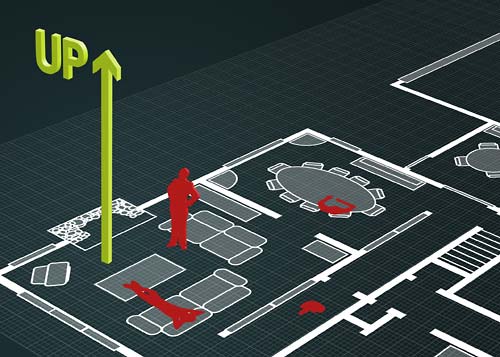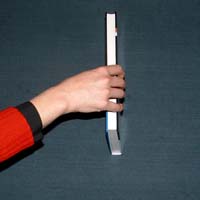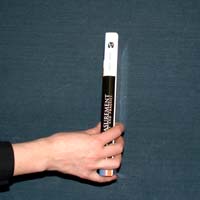
John Baez is a mathematical physicist at the University of California, Riverside. He specialises in quantum gravity and n-categories, but describes himself as "interested in many other things too." His homepage is one of the most well-known maths/physics sites on the web, with his column, This Week's Finds in Mathematical Physics, particularly popular.
In a two-part interview in the previous issue of Plus and this one, Helen Joyce, editor of Plus, talks to Baez about complex numbers and their younger cousins, the quaternions and octonions.
A new dimension

The plaque to Hamilton's discovery of the quaternions at Broome Bridge in Dublin. Photo courtesy of Tevian Dray
We resume our story with the invention of quaternions - lists of 4 numbers that come with a rule for multiplying and dividing. Describing the moment when inspiration struck, their inventor, William Rowan Hamilton said:
"And here there dawned on me the notion that we must admit, in some sense, a fourth dimension of space for the purpose of calculating with triples ... An electric circuit seemed to close, and a spark flashed forth."Hamilton's "in some sense" is revealing. He clearly felt that there was something strange about going into a fourth dimension when we normally think in a maximum of three, for obvious reasons. So what is this mysterious fourth dimension?
"Well, it took people a long time to figure that out," says Baez, "and I don't think Hamilton completely knew. He was thinking in an algebraic way, where you just make up rules. But his triumph was realising that you could think about it geometrically too. When he tried to think geometrically in 3 dimensions it just didn't work, until he started thinking about lists of 4 numbers, and the algebra came in and saved him.
"That's one thing we do a lot in mathematics: bounce back and forth between visualising things and scribbling formulas on paper, and neither one by itself is good enough. If you're only scribbling on paper and never visualising or using geometry, you end up doing things that are boring, or you wind up making mistakes and not being able to notice them - you leave off one minus sign and you don't notice that you're doing something silly. But then when you start trying to do the geometry of 4 dimensions - well, it's not so easy to see what that looks like and you need to use a lot of algebra to see how things should work.
"Later on, people decided that one good way to think about the fourth dimension is to think of it as time. Another way to do it is just to get good at imagining that there's some fourth direction you could go, that there's another direction at right angles to the three we know. Those kind of ideas were actually very popular in the late 1800s. Even now it's fashionable in some theories of physics to have extra dimensions."
And another answer for a mathematician is: Who cares? Just get on with doing some maths! But here Baez urges some caution. "It's good to have that answer in your box of answers, because you don't want to become stuck. Whenever you're doing something with algebra, and it runs ahead of your geometry or ability to understand, it's nice to be able to say: 'Well, don't worry about it, we just have some rules for playing around with these letters and numbers, it's like chess, you don't ask me why you can castle!' But I don't think this attitude is a good one to have ultimately. It just lets you get over certain humps; later on you figure out what you were really doing."
What's so special about 2 dimensions?
Recall that part of Hamilton's great breakthrough was to work out how to multiply two complex numbers, and that this had a geometric meaning: multiplying by a complex number rotates the plane and scales it. By analogy, he hoped that if he could work out how to multiply triplets, then this would provide a way to do rotations in 3-dimensional space. But although this was a clever idea, things just weren't that simple.
"It's very special to the number 2, that to describe a rotation and a stretching or squashing in 2 dimensions takes 2 numbers. As soon as you go past 2 it takes more; for lists of 3 it takes 4. What Hamilton really wanted was a way to multiply two quaternions, and there is a way to do that, but he also discovered that there was a way to use quaternions to rotate and stretch and squash 3-dimensional space in any way you want." So you can characterise quaternions as the things you need to do to 3-dimensional space what complex numbers are able to do for themselves!

Life is very different in two dimensions
The connection between quaternions and rotations in 3 dimensional space illuminates the strange property for which quaternions are best known. "The virtue of quaternions is that you can divide, and their vice - or strange defect in a sense - is that a times b doesn't equal b times a, that is, multiplication of 2 quaternions doesn't commute. People were shocked by that, but there's a good explanation, which is that if you look at rotations in 3 dimensions, they don't commute." It's a beautiful instance of the way seemingly different parts of mathematics are related to each other: algebra informing geometry, and geometry giving meaning to algebra.
You can see this in a practical example. Start by lying a book on a table, front cover towards you, right way up. Now flip the book over towards you, through 180o, so that it's lying on its front cover - it'll no longer be right way up. Then rotate the book through 90o by balancing it on the edge nearest to your left hand - it will now be resting on its spine.
Now put the book back in its starting position, and carry out these two operations in the reverse order. First you will rotate the book through 90o by balancing it on the edge nearest to your left hand - it will now be right way up and balancing on its spine. Now rotate it through 180o towards you - the spine is now towards you and the book is wrong way up.
The two results are not the same!
 |
 |
 |
 |
 |
 |
"Another way to say what's special about 2 dimensions is that rotation commutes. In 3 dimensions or more that's not true. So it's actually not a bad thing that quaternions don't commute: they need not to commute in order to be able to handle rotations in 3 dimensions." Baez becomes almost poetic. "Each dimension has its own personality: there are certain things that work in that dimension that don't work in any other dimension and make it interesting and fun to study."
Is that allowed?
"Although people were impressed by Hamilton's quaternions, some were shocked because nobody had ever before just made up a rule for multiplying. Some people thought that that shouldn't even be allowed! In fact, it's the main thing that makes the difference between a good research mathematician and a bad one. A good one will have some instinct for what is an interesting direction to explore, a bad one will make up whatever comes to mind. You can play any notes you want, but that doesn't mean everyone is going to be a Mozart. However, it is harder for most people to understand how it works in maths than in music. For some reason most people can appreciate music to some extent; in maths it takes much more practice to get a sense for what's powerful or beautiful or useful. Part of it is taste."And although taste has a subjective element, there is a surprising amount of agreement about what's good and what's not. Very few people prefer Chopsticks to Mozart, although we are of course free to do so. The same is true in mathematics. "There's a very surprising amount of consensus."
For the utilitarian among us, the idea of taste in mathematics may not be enough, but for them there is its utility. "We find complex numbers incredibly useful all through physics," says Baez. "Quaternions are a little less useful but they are used for rotations in 3 dimensions and for writing computer programs that do things with rotations in 3 dimensions. Shortly after Hamilton came up with the quaternions he was able to show that you could use them to do lots of interesting and useful things in physics."
"The quaternions became really popular and people wrote books about them. Then people figured out other ways to do some of the same things, and there was a huge battle, around 1890, 1900, between the people who liked vectors, and the quaternionists. The quaternionists lost the PR battle and the vector people won, in the sense that if you study maths or physics as an undergraduate now, there's a good chance you'll never hear about quaternions. Once upon a time, if you had studied classical mechanics, rotating bodies and so on, all of that would have been done using quaternions. But now people use vectors, and the dot and cross product."
Although Hamilton himself was very proud of the quaternions, they are not what he is remembered for today. His "Hamiltonian" - a setup to use the energy of a system to figure out all sorts of things - is still used constantly. But quaternions have fallen out of favour, which makes it rather poignant that Hamilton spent the rest of his life working on them and writing textbooks on using them in physics. "Quaternions came from Hamilton after his really good work had been done, and though beautifully ingenious, have been an unmixed evil to those who have touched them in any way," said the great physicist Kelvin. "But," says Baez, "the Hamiltonian is very much still used, so you don't need to feel sorry for him."
The idea of inventing a new number system caught the imagination of the time, and started a craze, especially in Ireland, for coming up with new algebras and giving them funny names. A lot of them weren't all that interesting," says Baez, "and a lot of them they claimed they could divide but they actually couldn't, so they were just wrong. And that's not allowed, that's not a matter of taste. Eventually, a subject of algebra developed, where you just consider all possible rules for multiplying, and you classify which ones are better, which ones satisfy which rules. So nowadays mathematicians aren't so excited by the quaternions because they know many different possible rules for multiplying, and quaternions are just like one specimen among many specimens."
Octonions: if 4, why not more?

What it needs is four more legs
Among the mathematicians working in this area John Graves, a friend of Hamilton. It was Graves who had first got Hamilton interested in the problem of describing the complex numbers as pairs of ordinary numbers. When Hamilton told Graves about the quaternions, Graves' immediate question was: if you're allowed make up a way of multiplying lists of 4 numbers, why not more? And the day after Christmas of that same year, he sent a letter to Hamilton saying he had succeeded in coming up with a number system that we now call the octonions, which are lists of 8 numbers, and that he had a way of multiplying them that also allowed him to divide. "Hamilton wrote back saying, just because it's bigger I don't know if it is better," says Baez. "He said something like, I have a horse with four legs, I don't know if your horse with eight legs will run twice as fast!
Recall that when Hamilton passed from complex numbers to quaternions, multiplication lost one of its normal properties: commutativity. It was Hamilton who first noticed that multiplication on octonions had lost another: the associative rule. That is, $$a \times (b \times c) \mbox{ did not equal }(a \times b) \times c.$$ With quaternions you lose the commutative law, with octonions you also lose the associative law. The main thing you're left with is the ability to divide.
Back then, Baez explains, to publish a paper you would need a member of a learned society to give a talk about it at a meeting of the society, and it would appear in the society's journal, in the transcript of the meeting. Hamilton promised Graves he would talk about octonions at a meeting of the Royal Irish Academy, but he was so excited about the quaternions he kept forgetting. But, a few years later, Arthur Cayley reinvented the octonions and published before Graves ever got any credit for it! Then Hamilton gave a talk saying actually Graves thought of them first, but they wound up being called the Cayley numbers for a long time. So Graves missed out on his credit.
"After that little farce," says Baez, "people didn't pay much attention to octonions for a while, but they have a nagging way of reappearing in all sorts of places. They were way too far ahead of their time. No-one used them for much of anything, except that whenever people would study some branch of maths to do with geometry, they would wind up discovering that there would be some weird exceptional case of what they were studying that could only be understood using the octonions. If you're studying rotations, there are special things that only happen in 8 dimensions, and there are lots of other things like that that are harder to explain.
"I've spent a long time just trying to understand them. What got me going on them is my interest in exceptions in mathematics. Often you can classify some sort of gizmo, and you get a beautiful systematic list, but also some number of exceptions. Nine times out of 10 those exceptions are related to the octonions. That intrigues me: what is the essence of octonions that makes them do what they do?

The numbers of reality?
"The most exciting example recently is in string theory, which is a theory of physics where people are trying to combine gravity with the other forces, and they found out that this theory only works if space and time have 10 dimensions. And the reason is that a string traces out a 2-dimensional surface in space and time, and it can wiggle around in whatever other directions are left available, and it turns out that the maths only works out nicely if there are 8 other directions for it to move around in! And the fact that they're appearing in physics adds to the allure."
Baez thinks that if string theory turned out to be true then octonions would become very fashionable. Who knows: if this is what the world is made of, there might be a time in the future when people in school learn dimensions 1, 2, 3 possibly 4, and 8!
To try your own hand at some quaternion magic, try these three problems on our sister website NRICH: